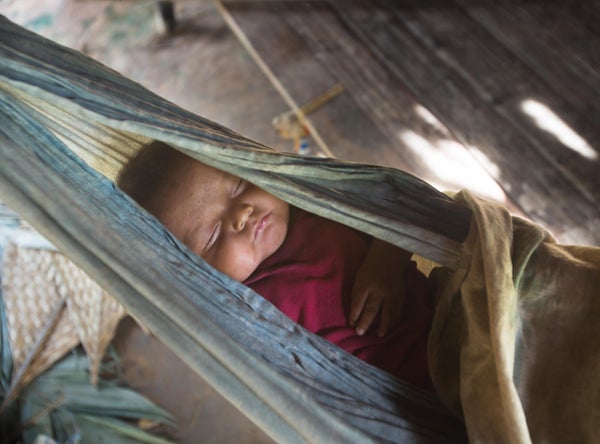In 1995 a landmark study found that children whose families were on welfare heard 1,500 fewer words every hour—or eight million fewer per year—than children from professional backgrounds. Eight years later these same children performed significantly worse on vocabulary tests and language assessments than their higher-income peers did.
These findings have influenced child-rearing practices ever since, and it is now taken for granted that the more time a parent talks to an infant, the better. In subsequent studies infant-directed speech has consistently been linked to a child’s language skills, which in turn influence IQ, executive function and emotion regulation.
Apparently, word of all this did not reach the Bolivian Amazon. A recent study published in Child Development revealed the Tsimané—members of a forager–farming society—speak to their young children for less than one minute every hour, roughly one tenth the amount of time U.S. mothers speak to their babies.
On supporting science journalism
If you're enjoying this article, consider supporting our award-winning journalism by subscribing. By purchasing a subscription you are helping to ensure the future of impactful stories about the discoveries and ideas shaping our world today.
The Tsimané, a so-called “preindustrial society,” are a favorite among anthropologists and health scientists. They have changed how we think about heart disease, color identification, sleep, music preferences, parasitic worms and genes for Alzheimer’s disease—and now language development. Their unique health and behavioral patterns are precisely why researchers need to study cultures that fall outside of so-called WEIRD—Western educated industrialized rich democracy—societies, says Michael Gurven, a professor of anthropology at the University of California, Santa Barbara, and director of the Tsimané Health and Life History Project.
The researchers observed, anecdotally, that language development appears to be slightly delayed in the Tsimané—but this does not seem to matter. The children grow up to be fully functioning, communicative and productive members of the community. In fact, as interactions between Tsimané and other Bolivians increase, many of the children are becoming bilingual in Spanish as well at their native Tsimané language.
Previous research on the Tsimané showed family and child-rearing dynamics are very different. Parents do not give their babies as much attention as Westerners do, and there is little playing with or soothing young children. But the children also cry less. One reason may be that they are with their mothers the vast majority of the time, so basic biological demands like breast-feeding can be taken care of immediately.
The Tsimané’s distinctive child-rearing styles may stem from a sobering reason: a high infant mortality rate. Thirteen percent of infants do not make it through their first year of life, most dying from infectious diseases. As a result, Gurven says, mothers may not want to become too attached to their babies early on, beyond keeping them alive. Many children are not given names until after their first birthdays. “You can imagine that active speaking and conversing with an infant as if it were like any other member of your family—or even as a way of speaking to yourself—you could see why that might be not that common in the context of high infant mortality,” he says.
Dean Falk, an anthropologist at The Florida State University who was not involved in the study, says it is not only the quantity of speech that matters in language acquisition but the quality. “Motherese” is the universal simplistic language and sing-song tone associated with baby talk. Although it may seem like an annoying by-product of encountering chubby limbs, big eyes and soft cheeks, there is a strong developmental benefit of speaking in baby talk. The accentuated vowels help children distinguish between words, while simplistic sentence structures emphasize teaching object labels.
Falk says when determining how the lack of direct speech impacts Tsimané children’s ability to learn language, she would like to know about the acoustic features of the speech they do receive. “There’s a good deal of cross-cultural variation in how people talk to babies,” she says. “What would be interesting would be if they would start looking at the quality. You know: What is this infant-directed speech like? How is it different from adult-directed speech?”
Tsimané children do overhear conversations between adults for roughly seven minutes every hour. Laura Shneidman, who has conducted similar research on the Mayan population in Mexico, says that although directed speech contributes more to children’s language acquisition, these overheard conversations could still be beneficial, particularly in non-Western societies. Preliminary data from Shneidman’s research suggest that although U.S. children do a better job of retaining learning through directed speech, Mayan children remember new information from both directed and overheard speech. “The importance of something being directed, per se, varies depending on your culture. Kids growing up in the U.S. get a lot of information that things you direct to them are important,” Shneidman says. “Kids in other cultures where observational learning is more prevalent don’t have those heavy cues that you should only attend and pay attention to things that are directed to you.”
Before you stop talking to your children, however, Shneidman notes that for Westerners, speaking to infants is still critical—especially when considerations like school and competition with other children are taken into account. “In the United States there’s a lot of evidence that talking to kids matters and has these effects on later acquisition,” she says. “I think what’s problematic is taking programs of intervention that have worked in the United States, and taking them wholesale to these other cultures.”
